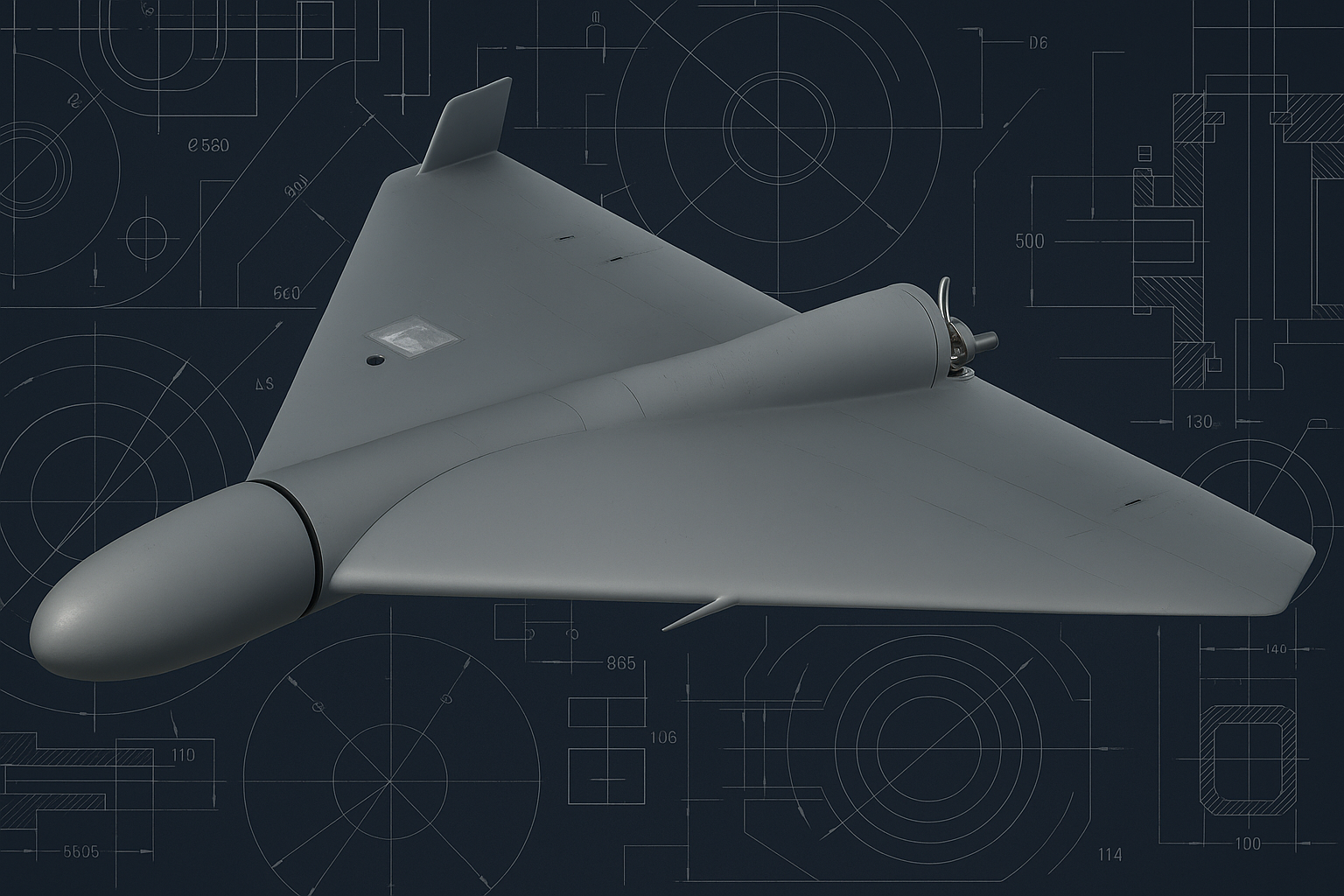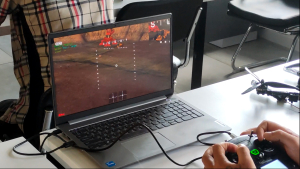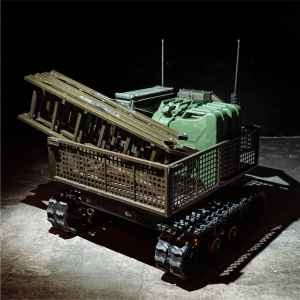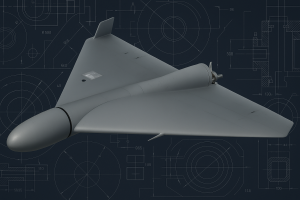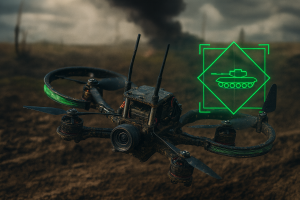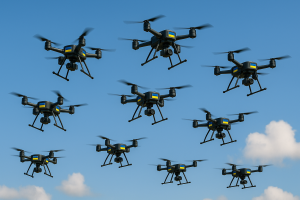What Are Shaheds?
“Shaheds” are a line of Iranian loitering munitions (kamikaze drones) developed by Shahed Aviation Industries. The most well-known model in this family is the Shahed-136. It is an unmanned aerial vehicle designed for long-distance flights and for striking ground targets upon impact.
In Russian reports, as well as in much of the world today, Iranian Shaheds are often referred to as the “Geran-2.” This is essentially the same drone, but under a Russian designation. Modified versions of “Shaheds” are now being manufactured in Russia itself, where they were given a new name.
History of Development — where, when, and why
Before the full-scale invasion, Shaheds were probably known in Ukraine only to people close to the military, defence, and scientific communities. Today the word appears in every news report. Iranian Shahed-136 systems were first unveiled in 2020. The maximum range the Shahed can cover — according to the manufacturer — is up to 2,000 km. The warhead weighs 50 kg.
Before the invasion of Ukraine, Shaheds (in other variants, mainly the Shahed-131) were used only in regional conflicts in the Middle East — for example, in Saudi Arabia — and their deployment was actively concealed.
Created in Iran as a low-cost means to strike ground targets — both industrial and military — Shaheds have become a weapon of mass use in Ukraine. The first transfer of Shaheds to Russia took place in the fall of 2022. Reuters reported that Iranian representatives visited Moscow on October 6, where they agreed on supply terms and a partnership regarding the drones.
In the summer of 2023, Russia began its own production of drones under the name Geran in Alabuga, Tatarstan. By the end of 2023, production had been scaled up significantly. According to CNN, the Alabuga plant produced 2,738 Shaheds in 2023. In the first nine months of 2024, this number doubled, reaching 5,760 UAVs.
By the end of May 2025, Russia was producing around 2,700 Shaheds per month, along with about 2,500 decoy drones, which are extensively used to drain Ukrainian air defenses. This is five times more than in the summer of 2024. Currently, production is running at about 170 units per day, and forecasts suggest that by autumn, this figure will rise to 190 units per day.
One of the most notable uses of Shaheds in the first year of the war was the attack on Ukraine’s energy infrastructure on October 10, 2022. On that day, Russia launched hundreds of missiles and dozens of Shaheds. These inexpensive loitering munitions, used together with missiles, proved to be quite effective against civilian infrastructure, leaving large parts of Ukraine in a prolonged blackout.
As at the beginning of the invasion, Shahed/Geran-2 is still primarily used as a tool for long-range strikes on critical infrastructure and for mass nighttime attacks. Modern Shaheds can fly up to 2,500 km. The drone is 3.5 meters long, with a wingspan of 2.5 meters. Weighing around 200 kg, a Shahed can reach speeds of over 185 km/h. Modern jet-powered UAVs can reach speeds of up to 500 km/h.
Its relatively large size and the noise of its flight make the Shahed detectable from a distance. However, at night these deadly “birds” are much less visible. In the dark, it is easier for them to evade air defenses, whose effectiveness is lower at night. The drone has a low speed and simple navigation (GPS/INS), which is one of the reasons why it is mostly used under cover of darkness, when detection systems are less effective.
A large number of UAVs allows the enemy to achieve its goal — not so much through precise strikes, but by “cluttering” air defense systems with a high volume of inexpensive targets. This diversionary tactic makes it possible to hit critical targets with just a few precise strikes.
Today’s Shaheds differ from the versions used by the enemy at the beginning of the full-scale invasion. The Russian side has integrated different components, giving the drones new capabilities.
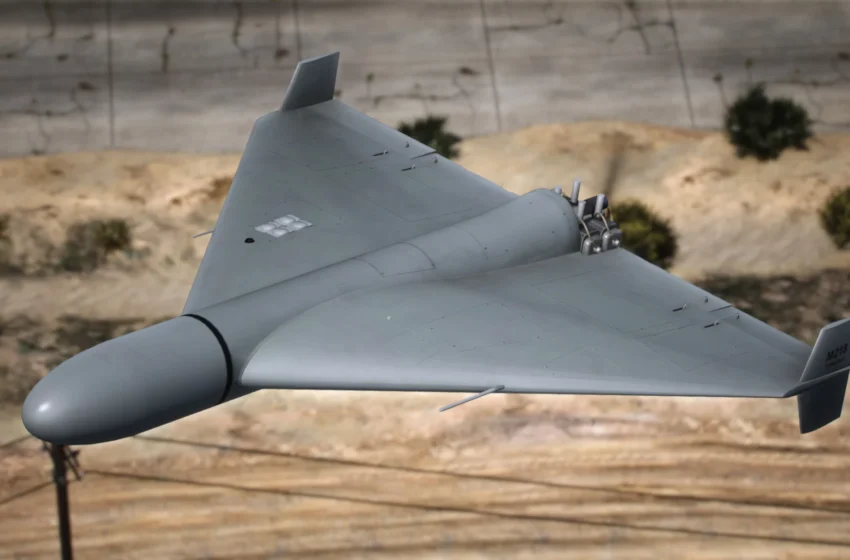
Imported controllers have been replaced with localized onboard computers and modules that use GLONASS. Thanks to this modification, Shaheds have become less dependent on Western components and more resistant to GPS signal jamming. Russia has also upgraded the antennas (installing Russian “Comet” control-reception pattern antennas) and made changes to structural elements — for example, using fiberglass over carbon fiber for the body and painting parts of the drones black for nighttime camouflage.
Experiments are underway to alter the warhead: some drones are fitted with warheads weighing up to 90 kg, and the warheads are being loaded with high-velocity ball bearings and tungsten shot. Compared to the original prototypes, the destructive power has increased significantly.
In the upgraded Shaheds, different engines have been found — locally made or alternative imported replacements — along with different batteries and servos. All of this makes it possible to change the range-to-payload ratio. Variants have already been discovered with built-in cameras and two LTE modems, which enables real-time video transmission and in-flight course adjustments. These UAVs are no longer simply one-way kamikaze weapons; their capabilities are expanding, allowing them to perform reconnaissance and target-adjustment missions.
Technological advances in Shaheds
A Shahed today is not the same aircraft that was used at the start of the war. Russia and Iran have been improving the weapon compared with early models. Innovations already in use include:
- improvements to warheads — (November 2024: Russia used thermobaric warheads; late April 2024: deployment of heavy 90-kg warheads);
- use of AI elements — (October 2022: adoption of GLONASS-based systems; from 2024 Shaheds have been fitted with anti-jamming CRPA antennas with FPGA and multiple microcontrollers);
- emergence of jet-powered Shaheds — fitting newer versions with jet engines allows speeds up to 500 km/h; such models are more difficult to detect, similar to a cruise missile (March–April 2025);
- since early 2025 — improved communications control and GPS anti-jamming: new radio solutions (LTE, etc.) enable remote control and strengthen resilience against electronic warfare.
It has also been confirmed that upgraded designs now use night-vision cameras, giving them a significant advantage at night. Over the past several months, their ability to “see” has improved notably:
- January 2024 — the first recorded use of a Shahed with a night-vision camera during an attack on Nikopol.
- June 2025 — a downed Shahed was found to contain an infrared camera and an Nvidia Jetson AI module.
- June 2025 — confirmed use of thermal imaging channels in Shaheds, allowing them to navigate without GPS and lock onto heat-emitting targets.
Maneuverability is what has made “hunting” Shaheds an even tougher task. Compared with the original Iranian models, modern Shaheds differ significantly. They’ve received improved flight control: Russia designed a new chassis with a more streamlined shape, reduced fuselage weight, and added carbon components. The drones have become faster and more agile, with more aggressive acceleration — yet their detectability by air defenses has decreased. Upgraded engines, stabilizers and controllers have all made Shaheds more accurate, and the number of hits on targets has increased. The updated technical baseline lets these drones execute diving maneuvers from 2 km altitude at speeds up to 400 km/h.
Localizing production not only allowed Shaheds to be significantly upgraded, but also reduced the impact of sanctions on their ability to be produced in large numbers.
Trends and the Scale of Escalation
The “saturation” of attacks is only intensifying. Back in October 2022, a single strike involved just a few dozen drones. Today, the number reaches into the hundreds. How has Shahed deployment grown over time? A brief digest:
- February 2023 — around 45 drones were used.
- February 2024 — just one year later, the number rose to 377.
- February 2025 — the figure climbed to 3,902.
- First five months of 2025 — Russia launched roughly 13,000 Shaheds and their decoys. On average, about 2,700 Shaheds are produced each month, along with a similar number of decoys.
- May 2025 — Ukrainian intelligence confirmed daily production at around 170 drones, with plans to raise output to 190 by year’s end.
- June 2025 — according to Ukrainska Pravda, became a record month: Russia launched 5,337–5,438 drones, more than in any previous month.
According to President Zelensky (June 24, 2025, in his address to the Senate and House of Representatives of the Dutch Parliament), since the start of Russia’s full-scale invasion, 28,743 Shaheds have been launched.
The First Hundred Drones in a Single Strike
In February 2025, Russia launched about 3,902 Shahed drones — averaging 120–140 per day. That daily average already surpassed the “100 units in one attack” threshold. Still, such massive strikes are not carried out every day.
The growth in simultaneous Shahed use became evident in spring 2025: on March 21, 214 drones were launched; on May 7, already 218. Since then, the numbers have only increased.
The First 500 Shaheds
June 2025 brought nights of unprecedented scale: on June 17 alone, 440 drones were sent toward Ukraine. Russia crossed the 500-drone threshold on September 7, 2025, when more than 800 drones and dozens of missiles filled the skies over Ukraine — the largest attack since the invasion began.
Consequences for Ukraine
Mass drone attacks from March to May 2025 severely strained Ukraine’s air defenses, prompting a reassessment of its protection structure — accelerating the procurement of air defense systems and the deployment of new tools, including interceptor drones, which have become a powerful weapon against Shaheds.
Learn how interceptor drones defend the sky over Ukraine — read on our blog.
The September 7, 2025 attack marked the peak of escalation. Civilians were killed and many more injured. This underscored the need not only to improve existing air defense capabilities but also to speed up the development of new systems.
Ukraine’s Countermeasures Against Shaheds
Today, Ukraine employs all available counter-drone measures, combining traditional air defense systems with innovative approaches and new organizational formats.
The first mass Shahed attacks in autumn 2022 prompted a response: Ukrainian forces established specialized mobile drone-interception units. These units move in off-road vehicles or trucks. To engage targets, soldiers are equipped with heavy machine guns, anti-aircraft mounts, MANPADS, thermal scopes, and searchlights. The mobile units’ mission is to patrol areas and quickly neutralize incoming drones.
Advantages of mobile units include speed and maneuverability, and they are less costly than using expensive air defense missiles. Their mobility allows them to cover areas without fixed air defense systems. However, their speed is insufficient to intercept Shaheds effectively. The number of units is limited, and their weapons are not always capable of handling the large number of targets appearing simultaneously. At a certain point, mobile units became less effective due to improvements in enemy capabilities: Shaheds capable of flying above 4 km became simply out of reach for mobile air defense teams.
To protect the skies, Ukraine has built a multilayered air defense system. In addition to mobile units, it includes:
- short-range air defense systems;
- MANPADS and anti-aircraft guns deployed across cities;
- more advanced systems supplied by partner countries (NASAMS, IRIS-T, Patriot) to defend critically important infrastructure.
Electronic warfare has also become a key tool. EW stations can jam navigation signals, diverting Shaheds off course or forcing them to crash in safe areas, including outside urban zones. Ukraine deploys both stationary and mobile EW stations.
The distinctive “moped” sound is one of the most well-known indicators of an approaching Shahed. Many cities have visual and acoustic observation posts that quickly relay information to mobile units and air defense systems.
Enhanced enemy weapons require innovative countermeasures. Ukrainian engineers are developing new anti-air systems with thermal targeting, as well as drone-based interceptors capable of shooting down Shaheds in mid-air or detonating them at safe altitudes. Counter-drone rifles and other signal-jamming tools are also deployed for air defense.
Shaheds Today
According to Ukrainian intelligence, Russia currently produces about 2,700 drones per month. Analysis of recent production increases and operational deployments suggests that Russia may eventually be able to launch up to 2,000 drones in a single night.
How many drones are being made, and where? At the start of the invasion, Iran supplied Russia with between 600 and 3,000 Shaheds, though exact figures remain unclear. More information is available on Russian production. For example, the Alabuga plant in Tatarstan significantly increased production volumes in 2024–2025: in 2023, it produced roughly 256 drones per month, rising to 444 per month in 2024. And that’s just one facility — there are many more.
The growing number and enhanced capabilities of these drones have prompted the search for new defense solutions.
Ukraine’s Response: Creating Interceptor Drones
The mass attacks in May–June 2025 required an immediate response. Ukraine focused on a new approach to air defense — interceptor drones. These drones allow the fight to move into a “drone versus drone” domain and reduce the burden on traditional air defense systems. For more details on how interceptors operate in Ukrainian skies, see our full article.
Fast, agile, and equipped with day and night cameras — his type of weapon may soon become the most effective counter to Shaheds. The primary mission of an “interceptor” is to stop an enemy drone before it completes its task. Various methods are used for this, including destruction and signal jamming. Many teams are working on interceptor drone development. One example is the “Clear Sky” project, focused on protecting the capital. In addition to deploying new interceptor drones, the project includes forming mobile units and training operators at a dedicated training center. About 550 Shaheds have already been intercepted over Kyiv Oblast through this system.
Ukraine’s Commander-in-Chief, Oleksandr Syrskyi, highlighted the importance of expanding the use of interceptor drones and training operators to counter Shahed attacks. He cited an example: of 502 drones launched in a single night, Ukrainian forces, including through the use of interceptors, shot down 430. This demonstrates the critical role of unmanned interceptors.
Interceptor Drones and the VGI-9 Guidance System
The very creation of Ukrainian interceptor drones, able to take down Shaheds in mid-air, marked a major advance in air defense. Yet the fight can become even more efficient. Cutting-edge systems are under development and testing, and guidance systems like the VGI-9 could play a pivotal role in enhancing interceptor capabilities.
One of the main goals of creating and deploying interceptors is to maximize the effectiveness of these “hunters,” enabling automatic target acquisition and tracking until destruction. This reduces the need for manual control and shortens reaction times.
Here’s how FPV drones with integrated guidance systems work:
- Without VGI-9 – the drone is manually controlled by the operator.
- With VGI-9 – the operator identifies the target and issues a capture command. From that moment, the drone flies autonomously toward the target until engagement. Resource usage is reduced, reaction time is shortened, and mission effectiveness is improved.
Ukraine’s cutting-edge interceptor drones — Sting, STRILA, and Clear Sky — have brought the fight against Shahed attacks, including large-scale waves, to an entirely new level.
Looking Ahead: What to Expect from Shahed Attacks in Fall 2025
The overall threat remains high, as Russia continues to increase production of Shaheds and Geran drones. This enables both regular raids involving several dozen to hundreds of drones, as well as massive attacks with over 800 drones per night. In response, production of new defense systems is accelerating, existing solutions — such as interceptor drones, mobile units, and electronic warfare systems — are being scaled up, and the networked air defense system is being refined.
In the coming fall and winter, the enemy will likely continue targeting energy and infrastructure, potentially causing disruptions to heating and electricity supply. Ukraine’s priority is to accelerate the production of interceptor drones and the training of operators, thereby increasing defensive capabilities. Equally important are offensive measures — and there are already many examples. Strikes on production facilities in Russia and on the enemy’s logistical routes help slow drone production, making massive nighttime attacks harder to execute.
Contact us to get detailed information about the VGI-9 drone guidance system.
Follow our updates on social media and YouTube – there you will find:
✅ Exclusive materials on the development, testing, and combat use.
✅ Useful analytical content on the war and the role of FPV drones in modern combat operations.
✅ The latest news and insights from the world of military technologies.
📌 Join us:
🔗 YouTube: VGI-9 on YouTube
📸 Instagram: We are on Instagram
🎯 TikTok: We are on TikTok



